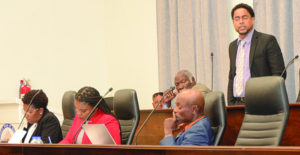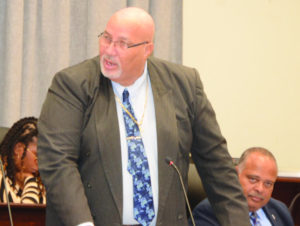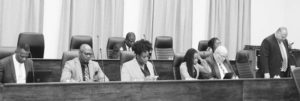
 A special sitting of the House of Assembly took place on Tuesday 26th September, 2023, in which the Honourable Premier and Minister of Finance, Dr. Ellis L. Webster, presented the Government’s Medium Term Economic and Fiscal Plan for the period 2024 to 2026.
A special sitting of the House of Assembly took place on Tuesday 26th September, 2023, in which the Honourable Premier and Minister of Finance, Dr. Ellis L. Webster, presented the Government’s Medium Term Economic and Fiscal Plan for the period 2024 to 2026.
 Typically, the Medium Term Economic and Fiscal Plan (MTEFP) sets out the Government’s plans and strategies for development over a three-year period with a focus on long-term growth.
Typically, the Medium Term Economic and Fiscal Plan (MTEFP) sets out the Government’s plans and strategies for development over a three-year period with a focus on long-term growth.
Following is the introduction by the Finance Minister of the Medium Term Economic and Fiscal Plan, 2024-2026:
“As the Minister responsible for public finance, my ambition is for all our people to have a fundamental understanding of matters of public finance, and to empower our people to be an informed and engaged citizenry.
“Today, we are here to consider our updated Medium Term Economic and Fiscal Plan 2024-2026 (MTEFP). The MTEFP serves as a bridge between our long-term development goals and objectives and our annual budgets. It is intended to ensure that fiscal and economic policies pursued are sustainable to support long-term growth. It supports the strategic allocation of resources to ensure the efficient use of public funds and ensures enhanced discipline through setting targets and limits for revenue and expenditure.
“In the MTEFP process, the government assesses the impact of all policy proposals and decisions covering a period of at least three years. The purpose of the plan is to provide guidance on fiscal operations, specifically to ensure efficient spending, maximize revenues to ensure fiscal stability, and minimize borrowing and debt.
“The legislative framework that supports the MTEFP is the Framework for Fiscal Sustainability and Development (FFSD), which is the Fiscal Responsibility Act (FRA) passed in 2013.
“The FFSD requires the development and annual update of a MTEFP, which facilitates the delivery of “a prosperous and stable future for the people of Anguilla firmly based on the implementation of sound economic and financial principles which support economic development.”
“The FFSD stipulates three guidelines: 1. that the ratio of net debt to recurrent revenue should be less than 80%; 2. that the ratio of debt service to recurrent revenue should be less than 10%; and 3. that the ratio of liquid assets to recurrent expenditure should be greater than 25%. In preparing this plan, my dedicated team in the Ministry of Finance first considers expectations for our macroeconomic framework, forecasting indicators such as GDP growth (the growth of our national output), and inflation (general rises in prices in our economy).
“Various alternative scenarios are prepared to model the impact of positive and negative shocks such as upticks in tourism or a severe storm. Following this, fiscal targets are set based on the forecasts for the macroeconomic climate. Here, we are looking at whether we will run a budget surplus or deficit and how we will manage public debt on a sustainable path.
“This process includes forecasting revenue, expenditure, and setting ceilings for the upcoming budget year. We review past expenditure trends and then allocate additional funds to priority areas based on national objectives. We then also look at fiscal risks and prepare alternative scenarios for how revenues and expenditure can be impacted by unanticipated events.
“These fiscal forecasts alongside sectoral strategies are refined and consolidated into the MTEFP, which must then be approved by Executive Council and the UK Government. This is all in accordance with the Fiscal Responsibility Act.
“The rationale behind these plans is simple: we aim to equip our government and our people with a strategic direction for our economic and fiscal journey. These plans provide a roadmap, ensuring that we are not swayed by short-term considerations but remain focused on our long term objectives. Just as a sailor uses a compass to navigate through turbulent waters, the Medium Term Economic Fiscal Plan will guide us through economic decision-making in fluid environments.
“Now, why do we have these plans in the first place? Making decisions in the absence of a plan is akin to sailing without a compass. We must have a clear direction and an understanding of the tides. We must exercise the wisdom to anticipate challenges ahead. We want to ensure that our ship, this beautiful island, Anguilla, avoids perils as it charts its course.
“At its core, this plan is more than just a compilation of words, numbers and projections. This plan embodies our vision, ambitions and planned actions for a prosperous future for our beloved Anguilla and its people.
“Before I go through the central elements of the updated plan, I first want to touch on a point that was subject to some discourse after my 2023 Budget Address, where I announced we had amassed modest reserves. At its core, building reserves is not about amassing wealth to boast. It is about remaining in control of our destiny through self-reliance, ensuring our preparedness in the face of uncertainty and creating a legacy of resilience for future generations.
“Building fiscal reserves is akin to a family setting aside monies to build their dream home or to invest in educating their sons and daughters. Just as a family sets aside monies for future investment or to be able to respond if there is an unexpected expense, such as illness, so too must Government. This is why we need a plan, an MTEFP. Instilling fiscal discipline ensures short-term spending decisions are made with a long-term outlook.
“In this updated MTEFP 2024-2026, you will see we plan to embark on significant capital expenditure of approximately EC$342 Million over the next three years. EC$267 Million of these funds will be allocated to investing in the Clayton J. Lloyd International Airport to develop a modern terminal and an expanded runway.
“Our recurrent revenues during those years will not be sufficient to cover our ordinary expenditure whilst accommodating such significant levels of investment. So how are we achieving this? Well, as you will see under the MTEFP, there is no proposed borrowing. Let me repeat, there is no new borrowing – no millstone around the necks of our children. Instead, we anticipate drawing down on those same reserves we amassed to fund this enhanced expenditure. This is why we plan – making spending decisions with a long-term outlook.
“Now I will turn to our policy priorities and economic strategies for the next year and beyond. These are the areas which we will be prioritizing and allocating additional funds to meet our national objectives. Our island has always been blessed with a spirit of resilience. This spirit is in the heart of every Anguillian. It is in our shared dreams and ambitions. In this plan, we lay out the blueprint for our journey towards that dream.
“Firstly, we recognize that the world is changing, and so must our public services. No more long lines or tons of paperwork. We are investing in digitizing government services, thus making them more efficient and accessible. For our entrepreneurs, our investors, for everyone – we are ensuring that doing business in Anguilla is seamless and swift.
“However, resilience is multifaceted. It is not just digital. It must also be enshrined in our physical infrastructure. We are planning significant investments in our airport and broader infrastructure to improve our productive capacity. Electricity bills have long been a burden for many. We are changing that. By fostering an environment that embraces affordable alternative energy, we aim to reduce energy costs and light up homes with both power and hope.
“To our local business owners, our Anguillians in the diaspora, and to our investor friends overseas looking for a place to grow – Anguilla is ready. We are refining our business climate, making it not only friendly for businesses but for fostering innovation and growth. To our youth, the future of this island, we are investing in you. Through enhanced sporting infrastructure and programmes, we are saying, ‘Your dreams and development matters.’ No more feeling disenfranchised. You belong.
“Lastly, we will develop the blue and green economy, which is considered as our best resource, besides our people. Our waters are so rich and bountiful. By strengthening our investment here, we aim to boost food production, ensuring that our island not only grows but also thrives.
“So, as we lay out this path for 2024 and beyond, remember: it is not just a plan; it is a pledge. A pledge to build, grow, and shine. It is a plan that will enable us to embrace the future with open arms, and to write a story of progress that generations will tell with pride.”
After Premier Webster presented the core of the Medium Term Economic and Fiscal Plan in the House, Members delivered their responses amid some back and forth wrangling on issues of social and political interest. The contributions and debates extended well into the night.








